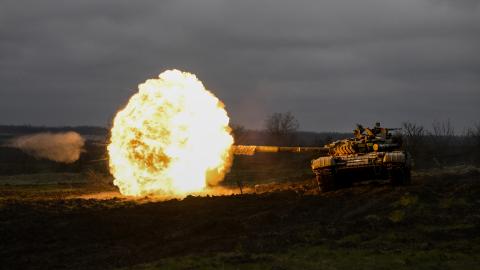After a winter of sustained Russian air strikes and extreme hardship, things are looking up for Kyiv.
As Moscow digs deeper into its older stocks of military hardware, Ukraine has received a steady flow of advanced Western military equipment. Across Europe, thousands of fresh Ukrainian soldiers have been trained. Following a freezing winter marked by power outages, Ukraine is once again exporting electricity to the rest of Europe. Defying the odds and expert analysis, Bakhmut still holds months after it was expected to fall to Russian forces.
Russia’s vaunted winter offensive has sizzled out, boasting few territorial gains. This week’s flashy drone strike against the Kremlin does not tell a good story for Moscow. If it was a false-flag operation, as seems likely, it was an incredibly desperate move by President Vladimir Putin — exposing how worried he must be about Russia’s prospects in the war.
In sum, these recent developments place Ukraine in a good spot to begin its much-awaited counteroffensive.
Unsurprisingly, expectations are high — perhaps too high. This isn’t a good thing for long-term Western support. Some commentators are suggesting future US assistance be linked to the operation’s success or failure.
This is the wrong way to look at the situation and fails to appreciate the type of war Ukraine is fighting. It’s not a series of annual hyped-up counteroffensives, and Western support should not be determined by perceptions of a single operation’s success. A dose of realism is desperately needed. Nothing in war happens as planned.
Images will likely emerge of burning or captured Abrams tanks or Bradley fighting vehicles given to Ukraine. It will not mean defeat. This is the reality of state-on-state warfare between two industrialized countries. Western policymakers and commentators need to be prepared for this eventuality. As with all wars, there will be ups and downs on the battlefield.
When the fighting stops someday, the goal for Ukraine is a strategic victory — but there will be tactical defeats along the way. If Ukraine’s counteroffensive stalls, or even fails, it’s no excuse to end support. On the contrary, it would be a time to learn from mistakes, keep the weapons flowing and the training going and prepare Ukraine for the war’s next phase.
Nobody other than a very small circle around President Volodymyr Zelensky knows what Ukraine’s objectives will be, how many trained troops are available or even when the counteroffensive will start. There is no single, identifiable event that marks the beginning of such a large-scale and complex military operation. In fact, Ukraine has likely commenced the very early stages of its counteroffensive already. Once it does begin in earnest, Western officials must be patient and calm. The operation’s success or failure won’t be known for months. Kyiv could see swift tactical victories early on.
Conversely, Russia may put up a stiff resistance that bogs down Ukraine’s attempts to break through defensive lines. But judgment should not be made until the counteroffensive fully plays out. There is an easy case to be made to the public that continued support for Ukraine is in America’s interest. The problem is, the White House isn’t making it.
Russia is one of our top geopolitical adversaries and an ally of China and Iran. For pennies on the dollar, the American taxpayer has enabled the Ukrainians to dismantle the conventional military of the Russian Federation. Thousands of Russian tanks and infantry fighting vehicles and hundreds of Russian planes, helicopters and drones have been removed from the battlefield forever — without a single drop of American blood and at a modest cost that totals less than 0.1% of America’s gross domestic product.
The White House needs to do a better job explaining this. And it must start wanting Ukraine to win more than it just hopes Russia will lose. US policymakers should see this war as a series of campaigns that will stretch for years instead of a disconnected series of battles lasting months.
Now that Ukraine is on the eve of its 2023 counteroffensive, America should not rest. Work should begin to prepare Kyiv for the upcoming winter and equip and train the Ukrainians for their 2024 military operations — now, not after the counteroffensive’s conclusion. This war will be long and measured by years, not months.
The West must start preparing to support Ukraine for the long term. Ukrainians are not asking for — nor do they want — US troops to help them fight Russia. All they request is the equipment, weapons, munitions and financial resources required to give them a fighting chance.
The Ukrainians have the will and the motivation, and the West has the weapons and the munitions.
Let’s give them what they need to get the job done.















